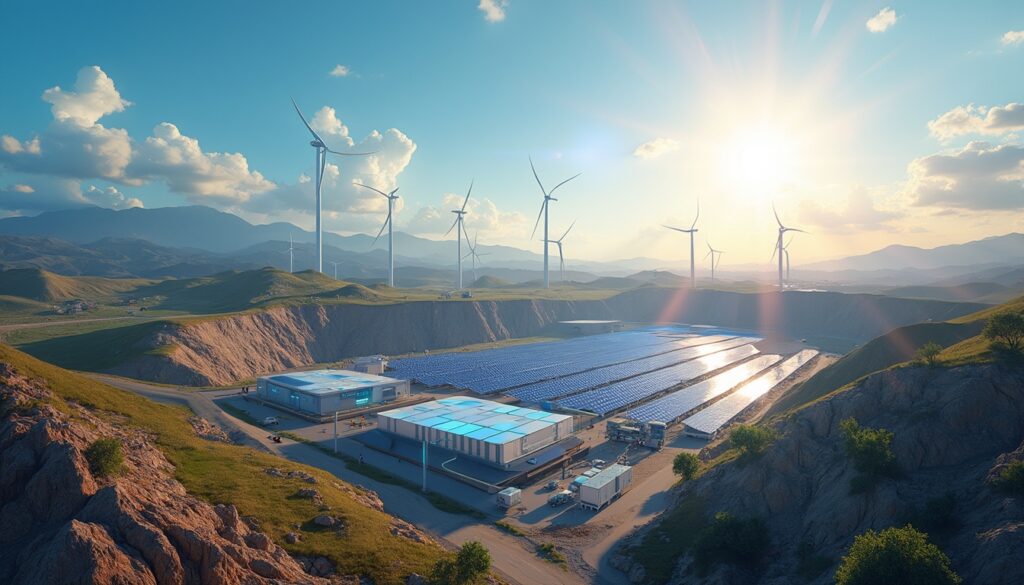Australia's mining sector stands at a decisive crossroads in 2025. Sustainability has become essential and renewable energy solutions in mining 2025 is driving remarkable change. In 2022, the industry produced 99 million tonnes of CO₂ equivalent, contributing 23% of Australia’s total emissions. This demonstrates mining’s immediate need to decarbonise.
Statistics indicate a required emission reduction of roughly 6% per year. This pressure has led to the emergence of initiatives like Australia’s clean energy revolution in mining, which embody the shift to greener practices. Investment decisions and operational strategies are increasingly influenced by these goals.
Industry expert Greg Lunt from Aggreko emphasised, "The mining sector's transition to renewable energy isn't solely about environmental responsibility. It is quickly becoming a business imperative, driven by investor demands, regulatory pressures, and operational economics." His views underscore the urgency for change.
Globally, mining operations contribute between 4-7% of carbon emissions. Mines producing essential minerals for renewable technology face particular scrutiny. Organisations such as the International Energy Agency are urging the industry to revisit its carbon footprint, supporting the move towards mining’s pivotal role in the clean energy transition.
In remote, arid locations, the economics of renewable energy have shifted dramatically. Hybrid renewable systems in these areas reduce the reliance on diesel by 40-60%. This transformation not only enhances sustainability but also significantly cuts running costs.
What Renewable Energy Technologies Are Mining Companies Implementing?
Many mining operations are adopting sophisticated hybrid power solutions. These integrate multiple renewable technologies to meet specific challenges. Hybrid systems often include:
- Battery energy storage systems (BESS)
- Solar microgrids
- Wind farms
- Integrated hybrid power stations
Battery energy storage systems dominate these solutions, with lithium-ion installations holding 90% market share. They provide grid stability functions like frequency regulation and synthetic inertia. Emerging technologies such as flow batteries are increasingly used for storage durations beyond 10 hours.
Solar microgrids have evolved through the use of single-axis tracking systems. These improve capacity factors by 25-30% compared to fixed panels. An installation at Gold Fields' Granny Smith mine, for instance, uses 8MW of solar generation coupled with a 2MW/1MWh BESS. This setup prevents millions of litres of diesel use.
Wind farms are gaining viability in areas with ample wind resources. Advanced turbines with dust protection and reinforced components have been engineered specifically for mining. These turbines showcase the innovative potential of renewable energy solutions in mining 2025.
In some projects, cutting-edge control systems such as digital twins enhancing mining sustainability add an extra layer of operational resilience.
Integrated hybrid power stations merge diesel generation with renewables and storage. According to Lunt, these systems often run on renewable power alone for 6-8 hours daily. A prime example is Rio Tinto’s Amrun Project. There, a 12.4MW solar farm reduces diesel consumption by 5.5 million litres every year. This reduction is equivalent to removing around 3,500 passenger vehicles from the roads.
The levelised cost of energy from solar installations now ranges between $30-50/MWh. In stark contrast, diesel generation costs between $150-200/MWh. This considerable economic advantage is driving companies to invest further in renewable energy solutions in mining 2025.
How Do Hybrid Power Solutions Benefit Mining Operations?
The benefits of hybrid renewable energy systems extend well beyond environmental gains:
- Reduced carbon emissions are a major outcome. For example, the solution at Granny Smith mine prevents 9,500 tonnes of CO₂ annually.
- Lower operational costs result in fuel savings of 20-40% compared to diesel-only systems.
- Scalability provides crucial flexibility. Projects can incrementally expand capacity as energy demands evolve.
- Uninterrupted power supply remains critical. Modern hybrids achieve ramp rates under two minutes for seamless operation.
These advantages culminate in improved ESG ratings. Renewable installations have garnered positive attention from sustainability-focused investors. Initiatives like Harmony Gold’s green initiatives boost investor confidence have played a pivotal part in enhancing investor perception.
With advanced predictive analytics and AI-driven control systems, renewable hybrids maintain excellent reliability. For instance, systems at the Granny Smith mine consistently achieve 98.5% uptime. Moreover, reduced maintenance needs further contribute to operational savings. Remote mines, in particular, benefit from reduced diesel fuel expenses and lower maintenance costs.
Which Mining Companies Are Leading in Renewable Energy Adoption?
Mid-tier mining companies are now spearheading renewable energy adoption. Their agile decision-making allows them to deploy technology faster than larger conglomerates. Gold Fields leads the way with its hybrid implementation at the Granny Smith mine. Their system, combining 8MW of solar power with 2MW/1MWh of battery storage, serves as a model for sustainable mining practices.
Encouraged by early successes, Gold Fields announced an expansion to 19MW of solar capacity in 2024. Similarly, Rio Tinto has launched ambitious renewable projects at multiple sites. At their Gove operation in the Northern Territory, two 5.25MW solar farms support bauxite refining.
Northern Star Resources is also making significant progress. Their renewable installations at the Jundee Mine have reduced energy costs by around 25%. Mid-tier miners typically allocate 15% of CAPEX to renewable initiatives compared to 8% by larger operators. This difference highlights a more nimble approach in embracing revolutionizing lithium production for clean energy.
Fortescue Metals Group is exploring green hydrogen and battery hybrid solutions. Their "Infinity Train" experiment combines regenerative braking with battery storage for iron ore transport. They target a transition to 100% renewable haulage by 2026.
To gain further insight into the broader context, consider exploring a detailed article on renewable energy's mining transformation. It offers additional perspectives on technology and market dynamics.
What Challenges Do Mining Companies Face When Transitioning to Renewables?
Despite their benefits, renewable projects in mining encounter significant challenges. High upfront capital investment remains the most formidable barrier. Comprehensive renewable retrofits at Tier 1 sites can range from $500 million to $1 billion. While long-term savings justify the investment, securing board approval can be difficult.
Infrastructure limitations present another hurdle. Remote sites often lack robust transmission networks. The installation of extensive solar arrays demands specialised logistics and construction expertise. These requirements can delay project execution in remote regions.
Additionally, technical gaps hinder progress. Mining engineers are usually well-versed in extraction techniques but may lack electrical system expertise. This gap means projects often require external consultants or partnerships, sometimes via Independent Power Producers (IPPs).
Approval processes can extend over 18-36 months. Such lengthy timelines often clash with the operational lifetime of certain mines. Grid inertia concerns also complicate matters. Conventional diesel generators provide natural frequency regulation, while renewables demand complex battery setups to mimic this performance.
External analyses, such as the recent renewable energy outlook, offer further details on overcoming these challenges. Mining executives must balance technical, logistical, and financial factors to implement sustainable practices effectively.
How Can Independent Power Producers (IPPs) Accelerate the Transition?
Independent Power Producers (IPPs) are playing a crucial role in enabling renewable energy projects. They provide specialised experience and innovative financial models that overcome high capital costs.
Some key benefits of IPP collaborations include:
- Zero CAPEX service agreements that allow mines to leverage renewable assets without upfront investment.
- Accelerated project timelines, as IPPs can deploy renewable infrastructure within 6-9 months.
- Mobile and modular solutions that adapt to shifting operational needs.
- Advanced optimisation through predictive analytics and robust control systems.
For example, Aggreko’s Weipa Project achieved operational status in just seven months after signing contracts. Their approach shortens feasibility studies by up to 70%. With rising renewable energy solutions in mining 2025, collaboration with IPPs is becoming increasingly appealing.
While IPPs offer growth and flexibility, mining companies must carefully negotiate performance guarantees and termination clauses. Transparent agreements help ensure adaptability as mine operations evolve.
What Results Have Been Achieved with Renewable Energy in Mining?
Real-world implementations provide compelling evidence of renewable success in mining operations. At Gold Fields' Granny Smith Mine, an 8MW solar array with a 2MW/1MWh battery delivers about 18GWh of clean energy annually. This reduction equates to avoiding 9,500 tonnes of CO₂ emissions each year. The system's 98.5% uptime matches that of conventional power sources.
Rio Tinto's Amrun Project further validates the benefits. A 12.4MW solar farm is expected to cut diesel consumption by 37%, amounting to an annual saving of 5.5 million litres. In current conditions, this results in roughly $4.4 million saved through reduced fuel costs.
Other projects reflect similar successes. For instance, the Peak Mines operation near Cobar, NSW reported overall energy cost reductions of 28%. Mining companies also report improved ESG ratings and benefits from lower maintenance requirements. Collectively, these successes highlight the transformative power of renewable energy solutions in mining 2025.
Gold Fields’ CEO remarked that renewables have significantly boosted ESG ratings. These improvements ease investor concerns dramatically and lead to greater capital attractiveness. Industry-wide, renewable hybrid systems are now achieving an average emission reduction of 22%—a strong outperformance compared to earlier projections.
What Is the Future of Renewable Energy in Mining?
The future of renewable energy in mining is set to become ever more ambitious. Technological innovations and improved cost efficiencies point to transformative change. Battery breakthroughs, such as solid-state batteries, predict storage costs could drop to around $50/kWh by 2030. This promises longer discharge durations and enhanced safety.
Experts predict that fully "thermal off" mines will emerge by 2028. Such mines could operate entirely without fossil fuel backup for extended periods. Continued solar expansion is anticipated, with a projected 30% compound annual growth rate. Gold Fields recently doubled its Granny Smith capacity to 19MW, a sign of robust industry momentum.
Green hydrogen offers a promising avenue for mobile mining equipment. Feasibility studies show that if production costs fall below $3/kg, hydrogen could become competitive with diesel. Integrated hybrid systems—combining wind, solar, and battery storage—are expected to achieve capacity factors exceeding 70%, rivaling conventional power systems.
Artificial intelligence plays an increasingly vital role in microgrid control systems. By optimising load management and energy dispatch, these systems enhance project economics significantly. This evolution reinforces the notion that renewable energy solutions in mining 2025 are not just viable, but essential.
What will drive further change?
• Continuous technological advances
• Stronger regulatory support
• Increasing investor demand for sustainable practices
Mining companies must all embrace these trends to secure a competitive advantage in the coming years. With the right blend of innovation, collaboration, and dedication, the industry is set to lead global decarbonisation efforts.
Renewable energy solutions in mining 2025 will remain a recurring theme as projects continue to deliver remarkable economic and environmental benefits. The journey is challenging but promising, with both mid-tier and Tier 1 operators realising the rewards.
Want to Stay Ahead of Major Mining Discoveries and Market Opportunities?
Discovery Alert's proprietary Discovery IQ model provides real-time notifications when significant mineral discoveries are announced on the ASX, giving you a critical edge in the market before wider recognition occurs. Explore how historic discoveries have generated substantial returns by visiting our discoveries page and position yourself for success in the evolving mining landscape.




